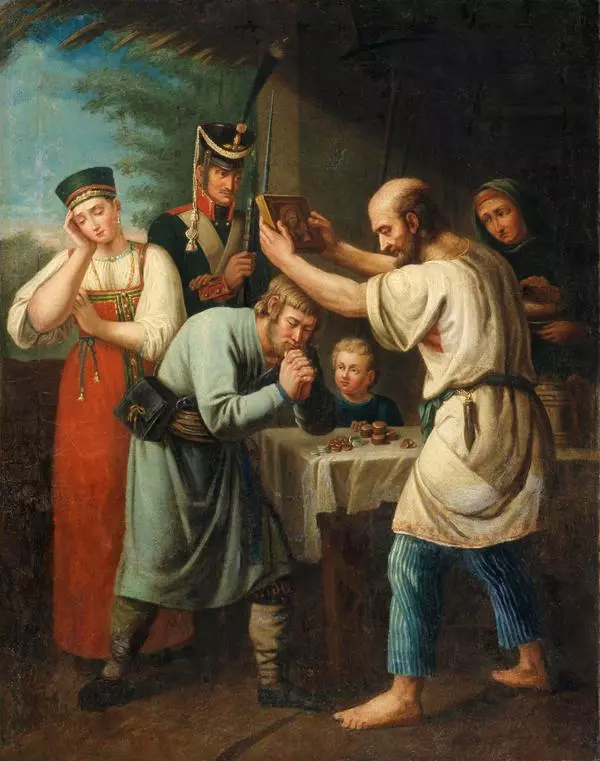The creative activity of the graduate of the St. Academy of Arts Ivan Luchaninov (1781, Toropets - 1824, St. Petersburg) did lasted only twelve years. At that time, the Great Patriotic War intensified the topic of patriotism and the interest in the life of ordinary people. Paintings of that time proclaimed the triumph of civic duty, classical plots, and the allegorical techniques gave way to modern reality.
Especially during this period, a new understanding of a real life event emerged in the pedagogical system of the Academy of Arts, which led to the appearance of competitive and examination programs on modern and quite relevant issues. Thus, in the academic program of 1812 appears a story about the people’s uprising, and for the painting ‘Farewell ceremony of the militia’, or ‘Blessing of the warrior’, the graduate ‘in the class of portraits’ Luchaninov received the gold medal of the Academy. This work was immediately widely recognized and served as an original for the espaliers and numerous engravings. It was also repeated with some changes several times by the artist himself.
The work ‘The Return of a Warrior from the Militia to His Family’ created by Luchaninov in 1815, later fell into oblivion. For a long time this painting and its variants were listed under a different authorship and had a different name. One of the versions is now in the collection of the Taganrog Art Museum.
This small canvas is devoted to a theme of modern ‘life’. It is made in a classical, strictly academic manner, and a fair share of idealization. There is a certain disproportion of figures relative to each other, as well as the influence of iconographic samples on the interpretation of one of the central characters. But through academic conventions, real emotions make their way here. The feeling of joy from the meeting of the militia with his family is expressed in the general composition of the scene. Particularly expressive is the real hero of this picturesque narrative. It is one of those true patriots of the Russian land, who ‘with honor and glory’ fulfilled his duty to the Homeland. The details of his military uniform and equipment are depicted with great care and factual accuracy.
Luchaninov’s work not only entered the extensive and varied chronicle of the Patriotic War of 1812, but also played a role in the development of new trends in Russian art in the early 19th century. Being a direct response to military events, this painting is a precious document of that era, a living voice of the time.
Especially during this period, a new understanding of a real life event emerged in the pedagogical system of the Academy of Arts, which led to the appearance of competitive and examination programs on modern and quite relevant issues. Thus, in the academic program of 1812 appears a story about the people’s uprising, and for the painting ‘Farewell ceremony of the militia’, or ‘Blessing of the warrior’, the graduate ‘in the class of portraits’ Luchaninov received the gold medal of the Academy. This work was immediately widely recognized and served as an original for the espaliers and numerous engravings. It was also repeated with some changes several times by the artist himself.
The work ‘The Return of a Warrior from the Militia to His Family’ created by Luchaninov in 1815, later fell into oblivion. For a long time this painting and its variants were listed under a different authorship and had a different name. One of the versions is now in the collection of the Taganrog Art Museum.
This small canvas is devoted to a theme of modern ‘life’. It is made in a classical, strictly academic manner, and a fair share of idealization. There is a certain disproportion of figures relative to each other, as well as the influence of iconographic samples on the interpretation of one of the central characters. But through academic conventions, real emotions make their way here. The feeling of joy from the meeting of the militia with his family is expressed in the general composition of the scene. Particularly expressive is the real hero of this picturesque narrative. It is one of those true patriots of the Russian land, who ‘with honor and glory’ fulfilled his duty to the Homeland. The details of his military uniform and equipment are depicted with great care and factual accuracy.
Luchaninov’s work not only entered the extensive and varied chronicle of the Patriotic War of 1812, but also played a role in the development of new trends in Russian art in the early 19th century. Being a direct response to military events, this painting is a precious document of that era, a living voice of the time.




